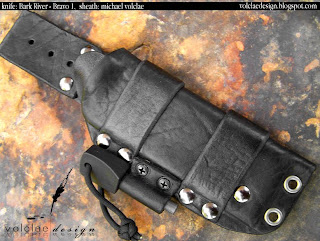Different types of sheaths are available for the survival knife, depending on how you prefer to carry it.

Kydex is a heat formable thermoplastic acrylic-polyvinyl chloride alloy material with good wear resistance and impregnable to water and bacteria. In some cases is has been known to brake (probably with intention), and the use in very low temperatures should be consider carefully and preferably tested. Most plastics have what is known as “glass temperature”, and below this the plastic will brake with a brittle fracture, like glass.
The kydex sheath are either fixed with a nylon web or a “tek-lok”. The widest webbings (43 mm) I use are MIL-W-4088 type 7 (Coded with dotted yellow line down the sides) or MIL-W-4088 type 13, both resin treated to MIL-W-27265(R). The slimmer types is generic nylon webbing, but with a quality that seems very good.
Other types of kydex sheaths and mounting systems are available on request.

I am no expert on leather, so I won’t go into details about the properties. It is usually no problem with this material, unless one is in a tropical rainforest where the combination of humidity, heat and bacteria can eat the stuff up, or just under water.
I prefer thick leather in the sheaths, around 3.5-4 mm. This makes the sheath stiff and gives a quality feeling. The standard sheath is of a regular pouch type with ample room for the belt. I also make horizontal sheaths for carrying in the belt on the back or on MOLLE-rigs. Other than that my leather is ruff stuff, and I don’t do decorations.


The nylon sheaths are specially made for me by Combatkit, and have a formed PVC reinforcement to protect the blade. These are available in black or olive drab. These are not the best sheaths, but will work as an extra sheath.
The standard sheaths are black kydex for knives with composite handles and pouch type leather for knives with wooden handles. Kydex is not available for knives with wood handle due to poorer wear resistance in the wood, and it really doesn’t look good. There is no problem in using leather sheaths with knives with composite handles. Both the leather sheaths and the nylon sheaths can be supplied as aftermarket parts, but as the kydex are formed specifically for each knife, the knife has to be returned for the fitting of new kydex.

 A bipolar stepper motor has two electromagnetic winding sets. Because of this, it's necessary to use some circuit to reverse the polarity of the winding. A common way to do this is through the use of an H-Bridge circuit.
A bipolar stepper motor has two electromagnetic winding sets. Because of this, it's necessary to use some circuit to reverse the polarity of the winding. A common way to do this is through the use of an H-Bridge circuit.
 I used the following diagram to pull the whole circuit together. There is an Inferred LED Interrupt sensor in this diagram. I'll talk about that in a subsequent post, so disregard for now.
I used the following diagram to pull the whole circuit together. There is an Inferred LED Interrupt sensor in this diagram. I'll talk about that in a subsequent post, so disregard for now. I loaded the following very simple circuit onto the Arduino. It sets the speed of the motor to 10 RPM. Also, it turns the motor one revolution and then waits 2 seconds before looping.
I loaded the following very simple circuit onto the Arduino. It sets the speed of the motor to 10 RPM. Also, it turns the motor one revolution and then waits 2 seconds before looping.




























